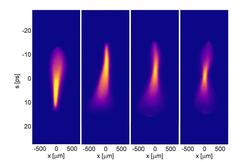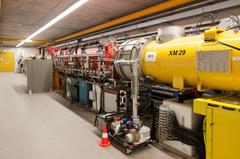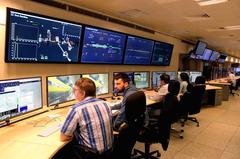URL: https://www.desy.de/news/news_search/index_eng.html
Breadcrumb Navigation
DESY News: Electron injector for European XFEL X-ray laser exceeds expectations
News
News from the DESY research centre
Electron injector for European XFEL X-ray laser exceeds expectations
DESY has successfully concluded tests of the first section of the particle accelerator for the European X-ray free-electron laser, European XFEL. The so-called electron injector, which is 30 metres long, performed distinctly better than expected. The injector already completed a whole week under operating conditions. “Having gathered much valuable experience, we are now all set to start up the entire accelerator complex,” reports Winfried Decking, the machine coordinator at DESY. “This is a huge success for the entire accelerator team, together with our international partners.”

The diagnostic system produces elongated images of individual electron bunches and allows to analyse them in slices. Credit: DESY
Built in an international collaboration in the Hamburg metropolitan area, the world’s best X-ray laser, the European XFEL, is about to be completed. It will produce extremely bright and ultra-short X-ray pulses, permitting a multitude of experiments to be carried out in the nanocosm – from determining the precise atomic structure of pathogens, to making ultra-slow-motion films of chemical reactions. The bright X-ray light is produced by small bunches of high-energy electrons which are brought to speed by a particle accelerator and then sent down an undulating magnetic path. At each magnetic bend in the path, the electron bunches emit X-rays which add up to a laser-like pulse in a self-amplifying manner.
DESY is the main shareholder of the company European XFEL GmbH and responsible, among other things, for building and operating the 2.1-kilometre particle accelerator. The injector is located at the very beginning of the accelerator. Its task is to supply tailor-made bunches of electrons to the main accelerator. The quality of these electron bunches is crucial to the quality of the X-ray laser pulses at the experimental stations, about 3.5 kilometres away. One important quality criterion is how narrowly the electron bunches can be focussed. “This so-called emittance is some 40 percent better than specified,” reports Decking.

The injector is 30 metres long. Credit: DESY/Dirk Nölle
In the past seven months, the injector, which produced its first electron beam in December, has given the accelerator team an opportunity to get to know all major subsystems of the entire accelerator facility: “The injector includes all the subsystems that are used in the main accelerator too,” says Decking. “This meant we were able to test and familiarise ourselves with them.” All in all, he says, no major obstacles were encountered throughout the several months of its test operation. The injector went offline on Monday, so that it can be connected to the main accelerator, for which commissioning is expected to start in October 2016. The whole facility is expected to be available for experiments as from the summer of 2017.

View of DESY's accelerator control centre, European XFEL section. Credit: DESY/Dirk Nölle



